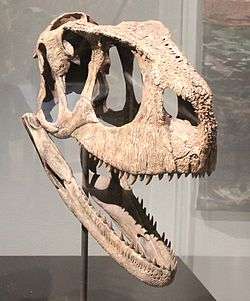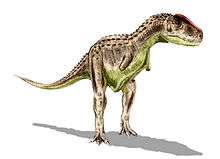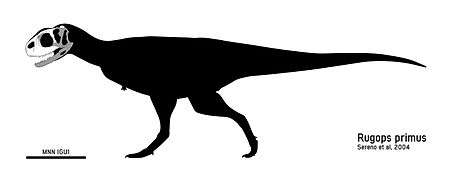Rugops
| Rugops Temporal range: Late Cretaceous, 95 Ma | |
|---|---|
 | |
| Restored skull | |
| Scientific classification | |
| Kingdom: | Animalia |
| Phylum: | Chordata |
| Class: | Reptilia |
| Clade: | Dinosauria |
| Order: | Saurischia |
| Suborder: | Theropoda |
| Family: | †Abelisauridae |
| Genus: | †Rugops Sereno et al., 2004 |
| Species: | †R. primus |
| Binomial name | |
| Rugops primus Sereno et al., 2004 | |
Rugops (meaning "wrinkle face") is a genus of theropod dinosaur which inhabited what is now Africa approximately 95 million years ago (Cenomanian stage of the Late Cretaceous). The discovery of a Rugops skull in Niger in 2000 was a crucial breakthrough in the understanding of the evolution of theropods in that area, and demonstrates that this landmass was still united with Gondwana at that stage in history.
Description

Though known only from a skull, Rugops was initially estimated as being 6 metres (20 ft) long based on comparisons with its relatives.[1] Later estimates suggest a revised length of 4.4 metres (14 ft).[2] The skull bore armour or scales, and other bones had many blood vessels, causing Paul Sereno, who led the team that discovered the fossil, to say, "It's not the kind of head designed for fighting or bone-crushing", suggesting that it may have been a scavenger. The skull also bears two rows of seven holes, each of unknown purpose, although Sereno has speculated that they may have anchored some kind of crest or horns.
Like other abelisaurs, Rugops probably had very short arms. These were probably useless in fighting. They may have only been balance tools, items to counterbalance the dinosaur's head.
The type species is R. primus (meaning "first wrinkle-face"), discovered in the Cenomanian-age Echkar Formation. Rugops is believed to be an abelisaurid, and is related to Majungasaurus.

See also
References
- ↑ Holtz, Thomas R. Jr. (2011) Dinosaurs: The Most Complete, Up-to-Date Encyclopedia for Dinosaur Lovers of All Ages, Winter 2010 Appendix.
- ↑ Grillo, O. N.; Delcourt, R. (2016). "Allometry and body length of abelisauroid theropods: Pycnonemosaurus nevesi is the new king". Cretaceous Research. doi:10.1016/j.cretres.2016.09.001.
- Sereno, P.C., J.A. Wilson, and J.L. Conrad. 2004. New dinosaurs link southern landmasses in the Mid-Cretaceous. Proceedings of the Royal Society of London (Series B) published online: pages 1–6.
External links
- Project Exploration on Rugops *Project Exploration news on Rugops
- Chicago Park District press release on Rugops, PDF format
- Sereno's speculation from "Science in Africa"
- Artist's impressions of Rugops, from Project Exploration
- Rugops in the Dino Directory
